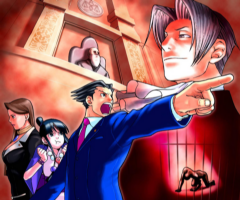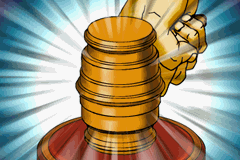|
. |
Capcom delivered a unique game to North American Nintendo DS
gamers on October 12, 2005. Phoenix Wright: Ace Attorney is like a breath of
fresh air. It's not a 3D first person shooter, a sports game, or a platformer.
What we have here is a humour filled text-based strategy adventure game in 2D.
 |
|
"Look behind
you! A three-headed monkey!" |
The game takes place about a decade in the future. It's the
story of Phoenix Wright, a defense attorney who has very little courtroom
experience under his belt when the adventure begins. His first case is a murder
trial which involves his childhood friend Larry Butz. Larry is accused of
murder, but Phoenix wishes to prove Larry's innocence. Phoenix has the guidance
of Mia Fey, the Chief of Fey and Co. Law Offices for whom Phoenix works. Mia
essentially acts as a tutor for the first Episode until the case is solved.
The goal of Phoenix Wright: Ace Attorney, is to prove, as Phoenix Wright, that
your clients are not guilty of the charges. The goal of Phoenix's opposition,
the prosecution, is to prove the defendant (your client) guilty of the charges.
The method to prove your client innocent is through the cross-examination of the
witnesses who are called in by the prosecutor. You must read through the text
and find contradictions with the evidence that has been collected. So, if for
example, the
witness says "I found the body at 9AM on October 12, lifeless", you can look
through your evidence. If you find an autopsy report stating that the time of
death was 1:30PM, October 12, that will allow you to raise a proper objection.
This is where Phoenix Wright makes his signature finger pointing pose that is
found on the box art. If you make an accusation with no relevance to the
evidence you presented, you will be given a penalty. After five penalties for
the current trial, the judge will give your client a guilty verdict and the game
is over.
If you can't find any contradictions, you can keep scrolling through the
testimony until you find one. There are no time limits. You can leave the game
on while staring at the statements for 5 hours, and the witness will just stay
there blinking away. If you can't find any contradictions in the testimony, you
can ask them to elaborate on their statements, sometimes adding to their
testimony. Of course, sometimes the prosecution will say that there is no need
to elaborate, usually out of fear that the witness will say something that will
lead to a contradiction. These are scripted, though, so it's not like the
prosecution will randomly deny your pressing of the witness.
Should you happen to find a contradiction, the judge will often ask the witness
to testify again. In this case, you know you are advancing the game.
At some point, the judge will ask you to prove your allegations toward to
witness, whether it be in the form of presenting evidence, or answering a
question correctly. You will also be advancing the game in this manner several
times during the trials.
There are several Episodes in the game that you can play through, each with
several chapters (except Episode 1), although the first time you play it you
will have to play through the game sequentially. The Episodes are related in
some manner with each other. From Episode 2 onwards, there is another aspect of
the game which I feel is not as exciting as the trial itself. This is the part
of the game where you have to go and investigate. While investigating in first
person mode, you have to look for clues and talk to people. This is an important
part of the story, as the evidence you collect and the people you talk to will
have relevance to the upcoming trial. You will have to present clues to these
people many times in order to advance the story or unlock other places to go in
the current chapter of the Episode. And this is one of the frustrating parts.
If you get stuck, it basically boils down to showing everyone everything until
something new happens. Seeing the same text over and over again regarding them
not knowing what the item is you're showing them isn't too bad, as once you've
seen the text once, you can speed it up by rapidly pushing the buttons on the DS
to advance the text. You cannot advance to the trial until you have collected
all the evidence and have talked to everyone that needs talking to, so you won't
be left high and dry when you arrive at the trial and find out that you needed
that seemingly useless piece of glass which you didn't pick up.
The game can be played using the stylus or the buttons. I find myself using the
stylus, as it makes it easier to choose the Press and Present on-screen buttons,
and to examine the scene in investigation mode.
 |
|
Phoenix points out a person who hasn't
played his game, Phoenix Wright: Ace Attorney. Do you really want to be
like him? |
Phoenix Wright: Ace Attorney also allows for the use of the
DS's built-in microphone. If you want to yell "Objection!", "Hold It!", or "Take
That!", you may do so where the game allows it. If you want to present some
evidence, you would push the Y button down, and then yell into the microphone,
and the game will recognize that you have yelled something and will proceed with
the game as if you had touched the Present button with the stylus. This game
does not have as complex a voice recognition as Nintendogs does, so you don't
have to enunciate at all. That's right, you can yell anything you want. You can
yell "Chowder!" and the game will still proceed.
The graphics, as I mentioned, are 2D. The characters are drawn in an anime
style, the colors are vibrant, and the animations aren't too bad either. It's
too bad that practically every location you are in features a static backdrop.
If you are in investigation mode and need to move from the Law Office to the
Detention Center, you will essentially fade to black and warp to the Detention
Center. If there are some people in the backdrop that are not as important, they
will be there, not moving a muscle. They will not have a detailed face, unlike
the important people who will basically take up the screen from their waist up
with a more detailed expressive face.
There are some other graphical annoyances as well. The game likes to use
frequent white flashes, usually as an indication that something is important and
needs to be remembered, or if there is a potential breakthrough that the player
has not initiated yet. I don't know if you would want this if you get epileptic
attacks, which is why video games have the recommendation to consult a doctor
before playing.
Also, I have noticed that there are some frames missing when Phoenix is in one
pose and then goes into another. For example, when Phoenix slams his podium and
goes into a pointing pose, I believe there are three frames: one for when his
hands are on the podium while he is leaning forward, one for when he stands
straight up, and one for the pointing pose. Or another example is when Phoenix
has just made an objection, and then presents a sheet of paper (used many times,
for a
photo, or an autopsy report, or any sheet of paper). You never see him pull the
paper out. It's just there. If there is evidence to be presented that is not in
a paper form, it will appear in a square as its icon, shown in the upper corner
of the upper screen and someone will talk about it as if someone was holding it.
 |
|
The verdict is in: the defendant is found
worth playing. |
The music is basically MIDI. There are no people singing or chanting, yet the
soundtrack is very fitting for the game. The music is lively and vibrant when
Phoenix explains why he made the objection, it's suspenseful when it looks like
you're about to lose the trial, and when you're out investigating, the music is
very fitting for the place that you are in. Sometimes you notice the music more
than the text you're reading. The sound effects aren't that bad, either. While
the gavel pound and desk slamming are memorable yet simple, there are times when
it sounds like someone just got punched in a fighting game, when really it's
just someone running in. This game does not have any voice acting except for
"Objection!", "Hold It!", or "Take That!", and these are voiced for Phoenix and
the prosecutors.
The game asks you to save at the end of each chapter, which is good considering
that the game will last about 20 hours or so.
You are allowed to save your game at any point, but this is not a true interrupt
save. This makes the game a little bit easier, as you are allowed to come back
to your file that was saved in the middle of the trial over and over again
(until you save again at a different point).
Once all the cases are solved, you may play the cases again in any order, with
the benefit of being able to make text go by quicker, and to see what happens if
you do other choices during the trials and investigation.
Would I recommend this game for everyone? I would definitely recommend it if you
have a DS, and don't mind the frequent white flashes. There is one problem
though. Capcom is not making this game anymore, and it is very difficult, if not
impossible, to find in retail stores today. For some reason, Capcom hasn't made
enough in the first place for North Americans. There is going to be a sequel
made, but it is going to be on cell phones instead. If you can get one through
auction sites, I say go for it. |
. |


